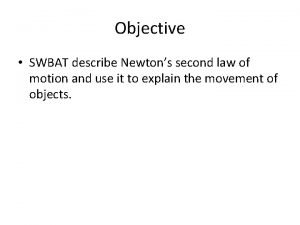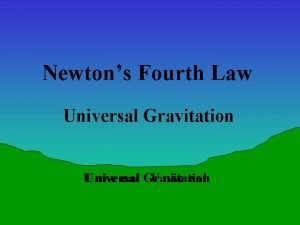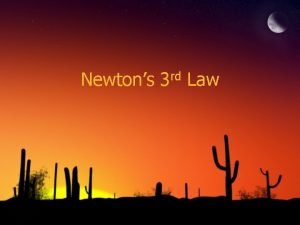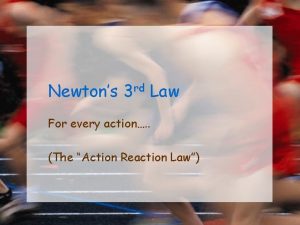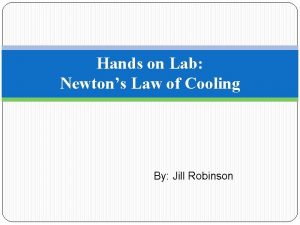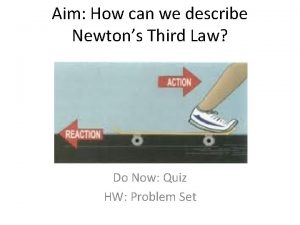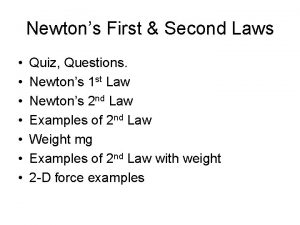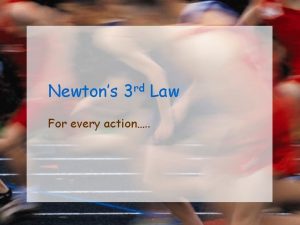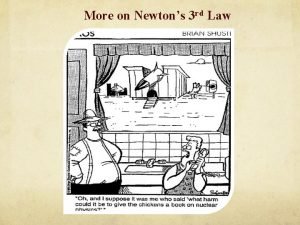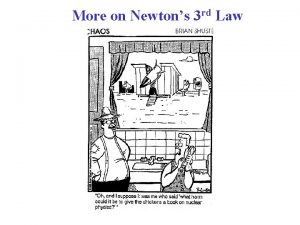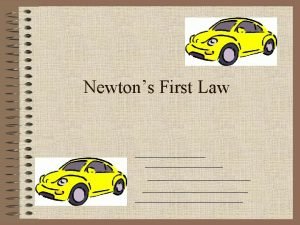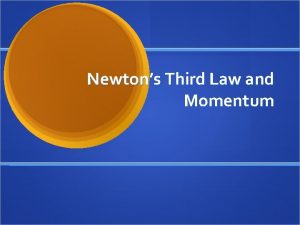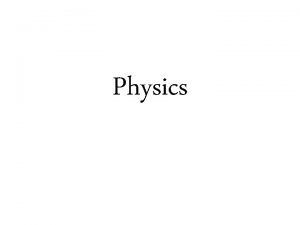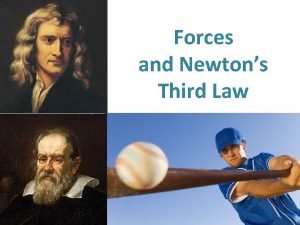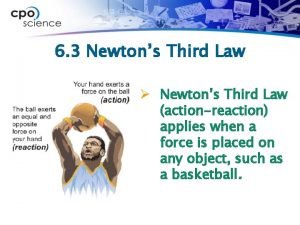Chapter 2 Lesson 3 Newtons 2 nd Law



















- Slides: 19

Chapter 2: Lesson 3

Newton’s 2 nd Law of Motion The acceleration of an object is equal to the net force exerted on the object divided by the object’s mass. Force = Mass x Acceleration = Force Mass The acceleration due to gravity on earth = 9. 8 m/s 2

Three Forms of Newton’s 2 nd Law If you want to find… Acceleration (a) Net Force (F) Mass (m) And you know… Net Force (F) and mass (m) Acceleration (a) and mass (m) Net Force (F) and acceleration (a) Then the formula you would use is…

Units for solving for Newton’s 2 nd Law � Identify the information you are given ◦ Look at the units ◦ Unit for Force – Newton (N) �Remember: Weight is a force due to gravity �If the problem asks you to solve for weight you need to identify the acceleration due to gravity for your given location. ◦ Unit for Acceleration – m/s 2 ◦ Unit for Mass – Kg or g � Use the appropriate formula

Practice Problem �A man has a mass of 66 kg on Earth. What is his weight?

Practice Problem � Johnny hits the baseball with 100 N of force. The baseball has a mass of 14. 2 kg. Identify the acceleration of the baseball.

Practice Problem �A girl on roller skates with a mass of 55 kg accelerates at a rate of 2 m/s 2. What is her force?

Practice Problem � Richie went fishing with his dad. He felt a bite on his line and started reeling the fish in with a force of 201 N. The fishing line was moving at an acceleration of 22 m/s 2. What was the mass of the fish that he reeled in?


An object at REST � Balanced Force The force exerted by the HAND is EQUAL to THE FORCE OF GRAVITY � Unbalanced Force The force exerted by gravity is GREATER than air resistance.

An object in MOTION � Unbalanced ACCELERATE forces cause objects to 1. Increase Speed 2. Decrease Speed 3. Change Direction

Part I: Acceleration Depends on Mass Acceleration decreases as its mass increases Acceleration increases as mass decreases Acceleration and mass are inversely related Example: You are pushing a shopping cart at the grocery store. At the beginning of your shopping trip, you exert a small force on the cart to accelerate it. (smaller mass = greater acceleration) Exert the same amount of force when the cart is full and the cart will not accelerate as much. (greater mass = smaller acceleration) http: //www 2. hawaii. edu/~kobatake/secondlaw 4. html

Part II: Acceleration Depends on Force Acceleration increases as the force on it increases Acceleration decreases as the force on it decreases Acceleration and force are directly related Example: When pushing the full shopping cart, if you push harder (greater force), the cart will move faster. If you push the full shopping cart with less force, the cart will move slower. **The acceleration is always in the same direction as the force applied. The shopping cart moved forward because the push was in a forward direction

� We know that objects with different masses accelerate to the ground at the same rate. � However, because of the 2 nd Law we know that they don’t hit the ground with the same force. F = ma 98 N = 10 kg x 9. 8 m/s/s 9. 8 N = 1 kg x 9. 8 m/s/s

Newton’s second law explains why objects fall to Earth with the same acceleration (9. 8 m/s) Less mass More mass Less Gravitational force More Gravitational force Less inertia = easier to move More inertia = harder to move

Type of Relationship Constant Force Mass Acceleration Mass Increases Acceleration Decreases ____ Force Increases Force Decreases ______ Acceleration Increases ____ Acceleration Decreases Mass Decreases ______ Force Increases Force Decreases ______ Acceleration Increases Mass Increases ______ Mass Decreases Inverse Direct

Circular Motion � Any motion in which an object is moving along a curved path. � For example: A rider on a merry-go-round moves in a circle. This type of motion is called Circular motion � If you are in circular motion, your direction of motion is constantly changing � This means you are constantly accelerating

Centripetal Force �A force that causes an object to move in a circular path � If you are constantly accelerating there must be a force acting on you at all times � The force exerted is the centripetal force and always points to the center of the circle.

� All CIRCULAR � Because MOTION requires a CENTRIPETAL FORCE the force acts toward the CENTER of the circular path, the acceleration must also be toward the CENTER
 Newtons 3 rd law of motion
Newtons 3 rd law of motion Newton's laws in soccer
Newton's laws in soccer Describe newtons second law
Describe newtons second law What object has more inertia
What object has more inertia Newton’s fourth law
Newton’s fourth law Newtons 3 rd law of motion
Newtons 3 rd law of motion Newtons 3 rd law
Newtons 3 rd law Newton's 3 law
Newton's 3 law Newtons 3 rd law
Newtons 3 rd law Newton’s cooling law
Newton’s cooling law Describe newtons third law
Describe newtons third law Law of thermodynamics in chemistry
Law of thermodynamics in chemistry Newtons st law
Newtons st law Newton's third law
Newton's third law Newtons 3 laws quiz
Newtons 3 laws quiz Newtons 3 rd law of motion
Newtons 3 rd law of motion Newtons 3 rd law
Newtons 3 rd law Every action has an equal and opposite reaction
Every action has an equal and opposite reaction Newtons 3 rd law
Newtons 3 rd law Newtons 3 rd law example
Newtons 3 rd law example


